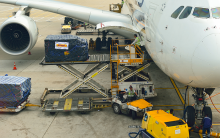 Global demand, measured in cargo tonne-kilometers (CTKs*), fell 10.6% compared with September 2021 (-10.6% also for international operations), but continued to track at near pre-pandemic levels (-3.6%).
Global demand, measured in cargo tonne-kilometers (CTKs*), fell 10.6% compared with September 2021 (-10.6% also for international operations), but continued to track at near pre-pandemic levels (-3.6%).
Capacity was 2.4% above September 2021 (+5.0% for international operations) but still 7.4% below September 2019 levels (-8.1% for international operations), said IATA’s latest reports. Following contractions across major economies, the global Purchasing Managers Index (PMI) for new export orders also contracted (for a third month in a row) to its lowest level in two years. Latest global goods trade figures showed a 5.2% expansion in August, a positive sign for the global economy. This is expected to primarily benefit maritime cargo, with a slight boost to air cargo as well. Oil prices remained stable in September and the jet fuel crack spread fell from a peak in June, the reports added. The Consumer Price Index stabilized in G7 countries in September, but at a decades high level of 7.7%. Inflation in producer (input) prices slowed to 13.7% in August. “While air cargo’s activity continues to track near to 2019 levels, volumes remain below 2021’s exceptional performance as the industry faces some headwinds. At the consumer level, with travel restrictions lifting post-pandemic, people are likely to spend more on vacation travel and less on e-commerce. And at the macro-level, increasing recession warnings are likely to have a negative impact on the global flows of goods and services, balanced slightly by a stabilization of oil prices. Against this backdrop, air cargo is bearing up well. And a strategic slow-down in capacity growth from 6.3% in August to 2.4% in September demonstrates the flexibility the industry has in adjusting to economic developments,” said Willie Walsh, IATA’s Director General.
Breaking News
- AISATS begins ground handling ops at Cochin International Airport
- EVA Air, EGAC, EGAS earn IATA’s CEIV Fresh & Live Animals certification
- Trishul Transport honoured with Best Road Transport Company award @ICA
- ‘2026 will belong to autonomous, sustainable supply chains’
- Trejhara to acquire LP Logistics for $9.5mn in strategic expansion
- Garudavega celebrates 12 years of excellence, leadership
- Jeena & Co received Pharma Cold Chain Provider award at ICA 2025
- IICS 2025 to foster air cargo innovation & tech
- Swayamgati Cargo launched by OSM to boost operations
- Om Logistics wins Supply Chain Management award in ICA
- Air cargo demand grew 4.1% YoY in October: IATA
 Cargo Breaking News
Cargo Breaking News


